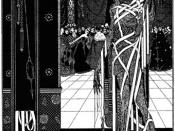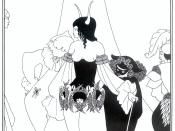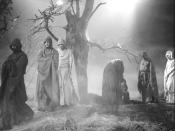"The Masque of the Red Death", a short story written by Edgar Allan Poe, is truly a frightening story that includes many symbols dealing with life and death. Each symbol gives a great deal of significance to the story and helps to enhance the lesson being taught. Symbolism found in the story is the ebony clock, the fact that the rooms represent the life cycle, and the black room alone.
The ebony clock, hid in the dark forsaken, western room of black velvet and scarlet portholes that allow one to gape amid the outside world, represents life and demise. The chiming of this timepiece corresponds to life. "It's pendulum swung to and fro with a dull, heavy, monotonous clang.... and there was a brief disconcert of the whole gay company..." Each musical resonance is time passed by and this terrifies the guests because each one is vexed by the fact that they could possibly depart this existence.
Following each chime comes a great stillness in the room. The echo vibrates the house as if it was and earthquake and the people within the house tremble with fear. It's as if these visitors are awaiting death. With each peal, their dreams recess until the last melodic tone is made. The minuet and the hour hand could possibly represent Price Prospero and the veiled figure, which in this story is the Red Death. At the end of the story, the masked figure was said to have been standing "...erect and motionless within the shadow of the ebony clock..." at about twelve o' clock. As the Prince approached this shrouded figure, he fell to his death and life ended with its age and process. The ebony clock gives meaning to the story because the story is dealing with life and death. The clock signifies the process of existence and death. Each chime symbolizes one more hour of subsistence surpassed. The clock is one of the most important items focused on upon reading this short tale. The clock also assists one to recognize the theme, one cannot wait for death, one must not be troubled by life, and one cannot buy their way out of death.
There are seven different rooms in this house, all bedecked in seven diverse colors. The rooms initiate in the east, and end in the west. "At the eastern extremity was hung, for example, in blue - and vividly blue were its windows. The second chamber was purple in its ornaments and tapestries, and here the panes were purple.... within the seventh apartment... the color of the windows failed to correspond with the room..." The east room, the blue room so enriched with light and life, is the first one may see and the west room, the black room so darkened with evil and death, is the last one may perceive. In between these two rooms are five more rooms whose colors are as followed: purple, green, orange, white, and violet. These seven rooms represent the life cycle. The blue room, lying in the far east, is birth and the black room, lying in the far west, is death. Each room amid the different rooms symbolizes a step in life. One may notice that the azure room is in the east, where the sun rises, and the black room is in the west, where the sun sets. The red light that glistens through the wine-red glass in the west room, reminds the guests of the danger of dying. These seven rooms give meaning to the story because they remind the reader of the seven stages of life. This also reminds the reader of the past significance of the number seven. The history of the world was thought to consist of seven ages, just as an individual's life had seven stages. The ancient world had seven wonders; there were seven deadly sins with seven corresponding cardinal virtues. As the Prince tries to catch the masked figure, he goes through the seven rooms, starting with the eastern one and ending in the final chamber of eternal night.
The west room, "...closely shrouded in black velvet tapestries that hung all over the ceiling and down the walls..." lighted by the beam "...a heavy tripod, bearing a brazier of fire..." that moves stealthily through the crimson windows, denotes death. The windows in each of the rooms corresponded with the color that room was adorned in, but the seventh room failed to do so. "The panes here were scarlet - a deep blood color" that seemed to set off an atmosphere of fatality, fear, and immorality. In this room lays the ebony clock, which measures another hour of life gone by. This dark, abandoned room has been said to be in the west. Death, the end of living, is in this way indicated by the setting of the sun, when light and life cease to exist. This room represents the closing stages of life, the end of the life cycle. This dark, untouched place gives meaning to the anecdote because it represents bereavement. This room is in essence the room of the Red Death.
This chilling story, The Masque of the Red Death, is an allegorical tale, representing life and death. This story includes many symbols with great meaning, but not every symbol was discussed. The progression of the rooms is significant because they can represent the life cycle. The movement from east to west symbolizes the journey from birth to death. The blue room was placed in the east, while the black room was placed in the west. The clock that sits in the forsaken room reminds everyone of death. The hourly ringing of the bells is a reminder of the passing of time, which pushes people on to their demise. When "... the hour was to be stricken, there came from the brazen lungs of the clock a sound which was clear and loud and deep and exceedingly musical.... and while the chimes of the clock yet rang, it was observed that the giddiest grew pale...", it was a reminder to the guests of brevity of life and the inevitability of death. The last room is black, a color that is often associated with morbidity. This room represents the end of life. Its "...effect of the firelight that streamed upon the dark hangings through the blood-tinted panes..." was a reminder of the danger of dying. These symbols very much so help the reader to understand the theme and lesson being taught. One cannot buy their way out of death, because money does not solve every dilemma in life. One must not await death because the suspense of waiting to die will only makes life harder to live. Take each day as a quest or a mystery, because God can seize a soul any time. One other premise to this tale was that even though death may be a few steps behind, it would soon catch up.


